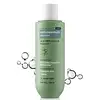What's inside
What's inside
 Key Ingredients
Key Ingredients

 Benefits
Benefits

 Concerns
Concerns

 Ingredients Side-by-side
Ingredients Side-by-side

Water
Skin ConditioningSodium Lauroyl Methyl Isethionate
CleansingCocamidopropyl Betaine
CleansingPropanediol
SolventDimethiconol
EmollientGlycerin
HumectantTea-Dodecylbenzenesulfonate
CleansingAcrylates Copolymer
Parfum
MaskingPiroctone Olamine
PreservativeSalicylic Acid
MaskingEpilobium Angustifolium Extract
Skin ConditioningPanthenol
Skin ConditioningRosmarinus Officinalis Leaf Extract
AntimicrobialNasturtium Officinale Extract
PerfumingSalvia Officinalis Leaf Extract
CleansingNiacin
SmoothingBiotin
AntiseborrhoeicAloe Barbadensis Leaf Extract
EmollientMenthol
MaskingMilk Protein
Skin ConditioningStearamidopropyl Dimethylamine
EmulsifyingGlycol Stearate
EmollientGuar Hydroxypropyltrimonium Chloride
Skin ConditioningMica
Cosmetic ColorantTitanium Dioxide
Cosmetic ColorantTin Oxide
AbrasivePEG-45m
HumectantSodium Chloride
MaskingCitric Acid
BufferingPhenoxyethanol
PreservativeSodium Benzoate
MaskingDisodium EDTA
Water, Sodium Lauroyl Methyl Isethionate, Cocamidopropyl Betaine, Propanediol, Dimethiconol, Glycerin, Tea-Dodecylbenzenesulfonate, Acrylates Copolymer, Parfum, Piroctone Olamine, Salicylic Acid, Epilobium Angustifolium Extract, Panthenol, Rosmarinus Officinalis Leaf Extract, Nasturtium Officinale Extract, Salvia Officinalis Leaf Extract, Niacin, Biotin, Aloe Barbadensis Leaf Extract, Menthol, Milk Protein, Stearamidopropyl Dimethylamine, Glycol Stearate, Guar Hydroxypropyltrimonium Chloride, Mica, Titanium Dioxide, Tin Oxide, PEG-45m, Sodium Chloride, Citric Acid, Phenoxyethanol, Sodium Benzoate, Disodium EDTA
Hibiscus Rosa-Sinensis Leaf Extract
BleachingMurraya Exotica Leaf Extract
AntioxidantAzadirachta Indica Leaf Extract
Skin ConditioningRosmarinus Officinalis Leaf Extract
AntimicrobialAcetum
Sapindus Mukorossi Fruit Extract
Skin ConditioningEmblica Officinalis Fruit Extract
Skin ConditioningAcacia Concinna Fruit Extract
Skin ConditioningBacillus/Coix Lacryma-Jobi Ma-Yuen Seed/Soybean Ferment Filtrate
AntioxidantGlycine Soja Extract
Skin ConditioningCocos Nucifera Oil
MaskingCaprylic/Capric Triglyceride
MaskingSodium Lauroyl Sarcosinate
CleansingCocamidopropyl Betaine
CleansingOlea Europaea Fruit Oil
MaskingAnanas Sativus Fruit Extract
Skin ConditioningOcimum Sanctum Leaf Extract
Skin ConditioningDecyl Glucoside
CleansingGuar Hydroxypropyltrimonium Chloride
Skin ConditioningSodium Cocoyl Isethionate
CleansingPolyquaternium-10
Xanthan Gum
EmulsifyingGlycerin
HumectantPhenoxyethanol
PreservativeEthylhexylglycerin
Skin ConditioningCellulose Gum
Emulsion StabilisingMagnesium Sulfate
Tocopheryl Acetate
AntioxidantHibiscus Rosa-Sinensis Leaf Extract, Murraya Exotica Leaf Extract, Azadirachta Indica Leaf Extract, Rosmarinus Officinalis Leaf Extract, Acetum, Sapindus Mukorossi Fruit Extract, Emblica Officinalis Fruit Extract, Acacia Concinna Fruit Extract, Bacillus/Coix Lacryma-Jobi Ma-Yuen Seed/Soybean Ferment Filtrate, Glycine Soja Extract, Cocos Nucifera Oil, Caprylic/Capric Triglyceride, Sodium Lauroyl Sarcosinate, Cocamidopropyl Betaine, Olea Europaea Fruit Oil, Ananas Sativus Fruit Extract, Ocimum Sanctum Leaf Extract, Decyl Glucoside, Guar Hydroxypropyltrimonium Chloride, Sodium Cocoyl Isethionate, Polyquaternium-10, Xanthan Gum, Glycerin, Phenoxyethanol, Ethylhexylglycerin, Cellulose Gum, Magnesium Sulfate, Tocopheryl Acetate
Ingredients Explained
These ingredients are found in both products.
Ingredients higher up in an ingredient list are typically present in a larger amount.
Cocamidopropyl Betaine is a fatty acid created by mixing similar compounds in coconut oil and dimethylaminopropylamine, a compound with two amino groups.
This ingredient is a surfactant and cleanser. It helps gather the dirt, pollutants, and other impurities in your skin to be washed away. It also helps thicken a product and make the texture more creamy.
Being created from coconut oil means Cocamidopropyl Betaine is hydrating for the skin.
While Cocamidopropyl Betaine was believed to be an allergen, a study from 2012 disproved this. It found two compounds in unpure Cocamidopropyl Betaine to be the irritants: aminoamide and 3-dimethylaminopropylamine. High-grade and pure Cocamidopropyl Betaine did not induce allergic reactions during this study.
Learn more about Cocamidopropyl BetaineGlycerin is already naturally found in your skin. It helps moisturize and protect your skin.
A study from 2016 found glycerin to be more effective as a humectant than AHAs and hyaluronic acid.
As a humectant, it helps the skin stay hydrated by pulling moisture to your skin. The low molecular weight of glycerin allows it to pull moisture into the deeper layers of your skin.
Hydrated skin improves your skin barrier; Your skin barrier helps protect against irritants and bacteria.
Glycerin has also been found to have antimicrobial and antiviral properties. Due to these properties, glycerin is often used in wound and burn treatments.
In cosmetics, glycerin is usually derived from plants such as soybean or palm. However, it can also be sourced from animals, such as tallow or animal fat.
This ingredient is organic, colorless, odorless, and non-toxic.
Glycerin is the name for this ingredient in American English. British English uses Glycerol/Glycerine.
Learn more about GlycerinThis ingredient is derived from guar gum.
It is a conditioning ingredient, meaning it helps soften skin and hair.
Phenoxyethanol is a preservative that has germicide, antimicrobial, and aromatic properties. Studies show that phenoxyethanol can prevent microbial growth. By itself, it has a scent that is similar to that of a rose.
It's often used in formulations along with Caprylyl Glycol to preserve the shelf life of products.
Rosmarinus Officinalis Leaf Extract comes from rosemary. Rosemary is native to the Mediterranean.
While Rosmarinus Officinalis Leaf Oil can be volatile due to its fragrant properties, the fragrance components are usually removed in the leaf extract.
Rosemary Leaf Extract contains many antioxidants such as rosmarinic acid and caffeic acid. Rosemarinic acid, a compound found in rosemary leaf, has been found to help soothe skin conditions such as eczema and acne.
Learn more about Rosmarinus Officinalis Leaf Extract